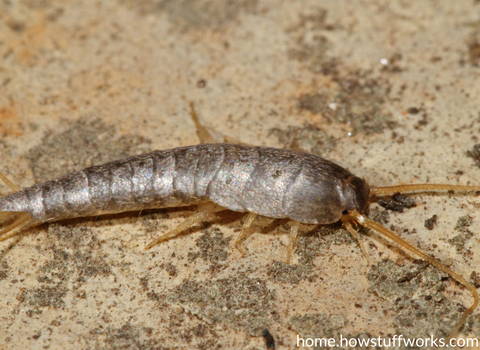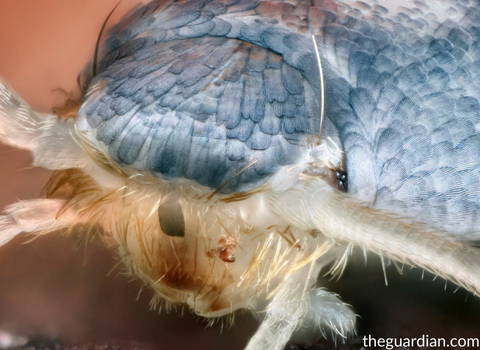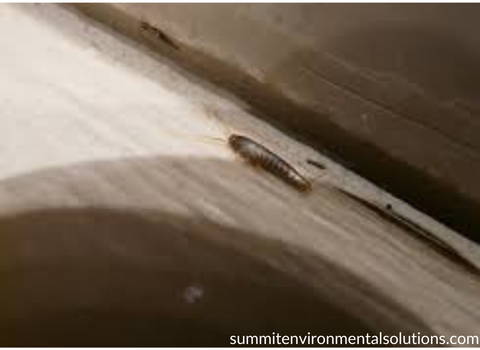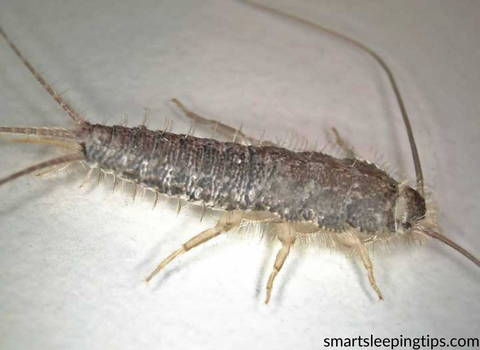What are Silverfish
Silverfish are insects that are also known as Lepismodes Glitellius. They are in the Thysanura order of the insect. While silverfish eat foods high in carbohydrates, protein is what their bodies mainly use for energy.
Silverfish look similar to fish in appearance because of the way they wiggle and swim instead of fly. They are about 1/2 to 3/4 inches long, which is exceedingly difficult to notice as they look like a dark-coloured piece of lint. Their colour ranges from silver, gray or white with 2 antennae and additional legs called cerci under their abdomen.
Lifecycle of Silverfish
The silverfish life cycle starts with the female who will lay eggs and then they hatch into larvae. The larvae stay as larvae for about a month and then they turn into pupae and enter the cocoon stage. The adults emerge from the cocoons in about two weeks, leaving the empty casing behind.
A female will lay anywhere from 100-400 eggs, and they will hatch within 30 days. The silverfish live up to 3 years. The silverfish breed quickly because of their short life cycle and their reproductive capabilities.
Silverfish larvae are whitish, about 1/4 inches long, and have three pairs of legs. They feed on the same type of material as the adults which is paper and glue.
The silverfish life cycle lasts from 3 to 6 months depending on what environment they live in. Silverfish can be found anywhere buildings exist such as basements, bathrooms, walls, or attics. They are also found in moist climates.
The silverfish infestation will not go away by themselves because they reproduce so quickly. If you suspect that you have a silverfish infestation, it is best to call a pest control expert as soon as possible for treatment before the numbers increase and spread throughout your home.
Once the first silverfish is seen, a house owner must recognize that it is a problem for their home and should immediately treat it. This insect is extremely hard to get rid of, so the longer someone waits the more silverfish that will enter their home.
In order to treat a silverfish infestation, a house owner must call a pest control expert for treatment.
What Attracts Silverfish
One way to get rid of silverfish is by learning what attracts them into your house and getting rid of those to prevent a silverfish problem from coming back. So, what attracts them? Check out the things below:
1. Protein and Carbohydrates
Silverfish feed on carbohydrates such as flour and rolled oats. They also feed on starches that are stored or present in book bindings, insulation, paper, glue, and cardboard boxes.
2. Dark and Warm Places
Silverfish tend to seek shelter in dark places with temperatures ranging from 70 to 90°.
3. Moisture
These pests are sensitive to moisture. They need highly humid places to survive so they are most likely found in humid and moist places. Silverfish tend to stay in kitchens, bathrooms, cabinets, garages, and laundry rooms. They can stray out of areas with high humidity, but only for a short period. These pests might seek shelter in areas with higher humidity.
Knowing what attracts these pests and even other pests helps in identifying the right methods to take to repel silverfish and control silverfish infestation.
Are Silverfish Harmful
Silverfish are not known to carry or spread disease. However, they do significant damage to paper products.
During the daytime, these insects hide in dark areas such as crevices, cracks, corners, and closets. In homes, they are commonly found hiding in books, shirt pockets, behind wallpaper, baseboards, and carpeting. They may go away for a few weeks or months at a time but eventually will return.
Damages that Silverfish Do
Silverfish do not bite humans, but they can damage fabrics and paper products. Silverfish will eat almost anything made of starch such as books, pictures, stamps, and envelopes. They also enjoy eating glue and wallpaper paste. Their feeding activity leaves irregular holes in paper and other materials.
These pests do not have chewing mouthparts, so they take little bites out of whatever it is they are nibbling on. They eat by sucking up their food, thus making them very undesirable house guests because of the damage they cause while looking for food.
Along with eating clothing, books, and wallpaper; silverfish will also moult their skin several times while growing into adulthood. The moulting process can create a buildup of silvery scales that look like dust throughout areas where the silverfish are seen.
At night, silverfish will run around on walls, floors, and ceilings. Their running activity can make them appear as though they are trying to escape the light.
They are not dangerous or poisonous but their presence in a home is damaging enough. While feeding, silverfish can leave irregular holes in paper materials and create unpleasant yellow stains where they have been eating.
Where Do Silverfish Come From
In order to better understand these insects, it is helpful to know where they come from and that is tropical rain forests. Silverfish are found throughout the world as well as in North America.
In their natural environment, silverfish eat decaying leaves and plants but in human surroundings, they will eat anything that contains starch. They are nocturnal insects which means they only feed at night and hide in dark places during the day.
Silverfish come from warm and humid climates where there are steady food sources. They prefer to live in damp areas such as bathrooms, kitchens, basements, and attics.
They can survive in most conditions, but they do have some limitations that prevent them from being able to live in certain places. Silverfish can not survive extremely cold temperatures, dry climates, and places without a ready food source.
These insects can be found anywhere in a building because of their ability to enter through any opening larger than 1/32 inches. Silverfish prefer areas with high moisture levels, but it is important to note that they can survive in drier climates as long as the humidity is above 50%.
Silverfish are hardy insects; they can live for months without any food.
Signs of Damage by Silverfish
If you see silverfish in your home, they already have laid eggs and it is an innovative idea to hire an exterminator for treatment. When inspecting items that may be affected by silverfish, look for the following signs of damage:
Irregular feeding holes on books or paper products.
Areas where there are scales of silverfish skin.
Irregular stains on cloth or paper where food has been eaten.
Darker colour around areas where they have been eating.
If you detect the presence of silverfish in your home, call a pest control professional for treatment as soon as possible because their larvae are most damaging to fabric items and things like wallpaper and glue.
Silverfish Control
The best way to kill silverfish is to call a pest control expert. Like other types of insects, it is not recommended that you treat silverfish by yourself because there are too many areas in your home where they can hide and enter.
While killing silverfish with chemicals works effectively for a short-term solution, it will not take care of the problem eventually; if the source of the infestation is not taken care of, silverfish will eventually come back into your home.
While different pesticides work best on each type of insect, the most effective over-the-counter bug killers for controlling silverfish are hydramethylnon and boric acid. These chemicals are food additives that insects consume which kill them slowly and effectively.
You can purchase bug sprays that contain either one of these chemicals and spray it on silverfish, but make sure to read all warning labels before you treat the infestation and always wear protective gear when using any pesticides.
While there are many diverse types of deterrents for silverfish, they will not work as long as a professional pesticide treatment.
For temporary relief, you can place bay leaves in your pantry which deters the silverfish by giving off a strong scent. Repel these insects with cedar oil or peppermint oil; both of these agents are natural insect repellents that make areas intolerable for silverfish to enter.
Although there is no completely safe way of getting rid of silverfish, you can reduce their numbers by cleaning your home regularly and sealing cracks and crevices where they may enter.
Silverfish are attracted to areas with moisture, so you must find the source of an infestation quickly. If there is a leak in your plumbing or anywhere else in your home; fix it immediately because this attracts silverfish.
Even if you find a way to kill all of the silverfish inside your home, it is almost impossible to keep them from coming back over time. Silverfish take 30 days after hatching before they become sexually mature and reproduce, which means that you will not see a decrease the silverfish population for at least that long. Unless you seal all possible entrances and take care of the source of an infestation, they will come back and more will soon follow.
Below are some products we recommend to control silverfish infestations:
Ways to Get Rid of Silverfish in Your Home
If there is an existing silverfish infestation in your home, the following are some tips that you can try to kill silverfish and get rid of them.
1. Reduce the Source of Moisture
You do not want these pests to keep coming back in your home and one way to do that is by repairing leaky faucets and pipes. Get a dehumidifier for damp areas to reduce humidity and water condensation. When cooking or taking a shower, use a ventilation fan. Keep downspouts and gutters free of any debris. Grade your landscaping as well so that water will drain away from your house.
2. Eliminate Openings
Limit the access of other insects and any other pests to your home by caulking all cracks and crevices behind and under baseboards and around door frames and windows. If you know that there are holes in the floors or walls where pipes pass, you might as well seal them all.
3. Remove Food Sources
You want to remove all food sources in your home that will attract silverfish. Make sure that you store pasta, flour, cereal, pet treats, and pet food in plastic airtight containers.
4. Vacuum Floors, Carpets, and Upholstered Household Items Regularly
Since silverfish lay and hide their eggs in narrow spaces, you have to target these areas whenever you are cleaning. Make sure that you empty the contents of your vacuum contents outside to prevent bugs from escaping and returning inside your home.
Try these tips and see if your silverfish infestation will finally end and avoid another infestation from happening. However, if you end up with large infestations, calling pest control experts can be your last resort.
Silverfish Prevention Tips
Once you have resolved the issue, it is recommended that you observe different ways to prevent silverfish and other pests from coming back. Check out the following:
Clean up all areas of the home including closets, attics, basements, and pantry. Silverfish like dark areas to hide in so keep them clean of clutter.
Vacuum all carpets in the home weekly. Remove all clutter in closets and storage rooms.
Keep firewood at least 18 inches away from the house exterior to prevent silverfish harborage under it.
Always caulk cracks and crevices in the exterior where silverfish can enter.
If you see signs of silverfish contact a pest control professional for treatment immediately.






